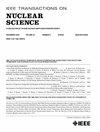The Effect of Number of Fins per Transistor on the TID Response of 12LP FinFET Technology
IF 1.9
3区 工程技术
Q3 ENGINEERING, ELECTRICAL & ELECTRONIC
引用次数: 0
Abstract
This article presents an analysis of the total ionizing dose (TID) response of n-channel transistors in the 12LP fin-based field effect transistor (FinFET) technology, with a focus on the impact of fin count per transistor. Previous studies, such as those by Vidana (2023), have shown increased每晶体管翅片数对12LP FinFET技术TID响应的影响
本文分析了基于12LP翅片的场效应晶体管(FinFET)技术中n沟道晶体管的总电离剂量(TID)响应,重点讨论了每个晶体管的翅片数的影响。先前的研究,如Vidana(2023)的研究表明,由于浅沟槽隔离(STI)氧化物中的电荷积聚,n沟道finfet中的断开状态电流($I_{\text {DS}-\text {off}}}$)增加。然而,这些趋势根据设备中使用的鳍片数量而变化。这项工作引入了一个基于物理的数据驱动模型,该模型由TCAD模拟支持,以解释鳍数对TID响应的依赖。该模型确定了不同STI区域电荷捕获的可变性,特别强调了氮化硅层在减少两个或更少鳍片器件泄漏方面的作用。这项研究不仅证实了先前的发现,而且为纳米级finfet独特的静电灵敏度提供了新的见解,为更好地理解TID效应和潜在的器件硬化策略提供了新的思路。
本文章由计算机程序翻译,如有差异,请以英文原文为准。
求助全文
约1分钟内获得全文
求助全文
来源期刊

IEEE Transactions on Nuclear Science
工程技术-工程:电子与电气
CiteScore
3.70
自引率
27.80%
发文量
314
审稿时长
6.2 months
期刊介绍:
The IEEE Transactions on Nuclear Science is a publication of the IEEE Nuclear and Plasma Sciences Society. It is viewed as the primary source of technical information in many of the areas it covers. As judged by JCR impact factor, TNS consistently ranks in the top five journals in the category of Nuclear Science & Technology. It has one of the higher immediacy indices, indicating that the information it publishes is viewed as timely, and has a relatively long citation half-life, indicating that the published information also is viewed as valuable for a number of years.
The IEEE Transactions on Nuclear Science is published bimonthly. Its scope includes all aspects of the theory and application of nuclear science and engineering. It focuses on instrumentation for the detection and measurement of ionizing radiation; particle accelerators and their controls; nuclear medicine and its application; effects of radiation on materials, components, and systems; reactor instrumentation and controls; and measurement of radiation in space.
 求助内容:
求助内容: 应助结果提醒方式:
应助结果提醒方式:


